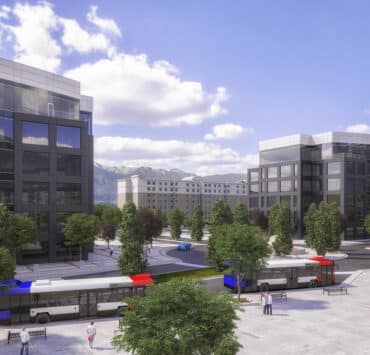|
Getting your Trinity Audio player ready...
|
One need not be a tree hugger to find the growth of utility-scale renewable energy to be pretty exciting. The growth curve is getting steeper, costs per kilowatt easily beat fossil fuels, and electricity consumers are saving money.
In the US, installed capacity of solar and wind farms grew from 40,000 megawatts built in 2010 to 140,000 megawatts constructed in 2019. Federal regulators gave the go-ahead in May 2021 to Vineyard Wind, a joint venture between Copenhagen Infrastructure Partners and Avangrid Renewables, a leading American sustainable energy company, to build the first commercial-scale offshore wind project (Vineyard Wind 1). It will power more than 400,000 homes and businesses in Massachusetts.

“Offshore has a very bright future,” says Jody Snodgrass, Avangrid Renewables’ vice president of projects. “The wind is always blowing offshore.”
Vineyard Wind 1 is projected to create 3,600 full time equivalent (FTE) job years, reduce carbon emissions by more than 1.6 million metric tons per year, and reduce electricity rates by $1.4 billion over the first 20 years of operation.
For Snodgrass, being in charge of renewable energy is a dream job. Not simply because it’s a major step toward a sustainable future, but also because he really likes building things—big things.
Whether it’s wind farms, solar farms, or even petroleum refineries, Snodgrass’s work on large-scale projects comes with inevitable challenges equivalent to their size. Most are on land in remote locations, while offshore wind farms are in the ocean; Vineyard Wind 1 had to be beyond the sightlines of pricey resort property, 15 miles off the coast of Martha’s Vineyard.
But as more projects get built, techniques and efficiencies improve. The actual design of a renewable energy project and its construction can happen in as little as a year. But what consumes far more time—two to five years, typically—is the development phase. This is when permitting and renewable energy financing (such as power purchase agreements, or PPAs) are orchestrated and achieved.
Snodgrass participates in this phase as well and speaks of his appreciation for it: “Permitting is a process of figuring out the right way to do things,” he says. “We need to study environmental impacts, address local concerns, and satisfy federal, state, and local requirements.”
That ease with what others consider obstacles is part of the Snodgrass method of project management.

He approaches projects in three steps. First, it’s about selling the vision to various stakeholders and employees. Second, it’s on him to muster the resources (money, people, software, etc.) to do the job. And throughout, particularly as his staff and their contractors go to work, it’s a matter of eliminating roadblocks.
“The most important first step is to show everyone why a project is important to them. I look at whatever their goals are and leverage that in an upfront, transparent way,” says Snodgrass, adding that it’s important to do much of that in one-on-one conversations. He takes care of these systematically by speaking every two weeks with each of his 20 direct reports and second-level team members. “People aren’t always able to say what they’re really thinking in a group setting.”
Snodgrass also likes to describe himself as “the dumbest guy in the room,” meaning he likes to hire people he considers to be better versed in certain topics than him. And as he leads, he avoids doing so in a demeaning or intimidating way. “My project managers are really risk managers,” he says. “And every project has problems. If they were to hide anything, it would only make the problem worse.”
This management style is effective and a real plus for Avangrid Renewables, which is in a hypergrowth phase. The firm has a portfolio of energy generation projects currently valued at $3.5 billion—individual installations cost between $75 million and $400 million to build—a number that will double by the end of 2022.
A new contributor to that growth will be the company’s commercial-scale green hydrogen project. Avangrid Renewables’ parent company, Spain-based Iberdrola, is a leading developer of green hydrogen in Europe. It uses renewable energy to power the conversion of water to hydrogen, making it in essence a carbon-free process. This in part solves for the problem of wasted energy from overabundant renewables, such as on sunny days, when production exceeds use. Snodgrass says the company can instead sell that excess energy to commercial customers.
With an MBA in data analytics, Snodgrass is keen to apply data to construction processes and operations—to yield smarter, better ways to build. “Productivity in manufacturing has doubled over the past 30 years but only increased by 5 percent in construction over that same time period,” he notes, mentioning such developments as drones, biometrics, and RFID technologies as important new tools for improving upon that.
The future of renewables, and methods for building renewable energy production, is exciting indeed.
As a pioneering company working to deliver a better energy future, Avangrid Renewables looks to proven technology to ensure that it can successfully deliver its growing portfolio of projects. Oracle Construction and Engineering is proud to support this mission with leading cloud solutions that accelerate performance, mitigate risk, and yield data-driven intelligence. A longtime user of Oracle’s Primavera solutions, Avangrid Renewables’ Vice President of Projects Jody Snodgrass has implemented Oracle Primavera Cloud Service to manage project scheduling and is working to add other Oracle software, including Primavera Unifier, to help his company power end-to-end capital program management success.


